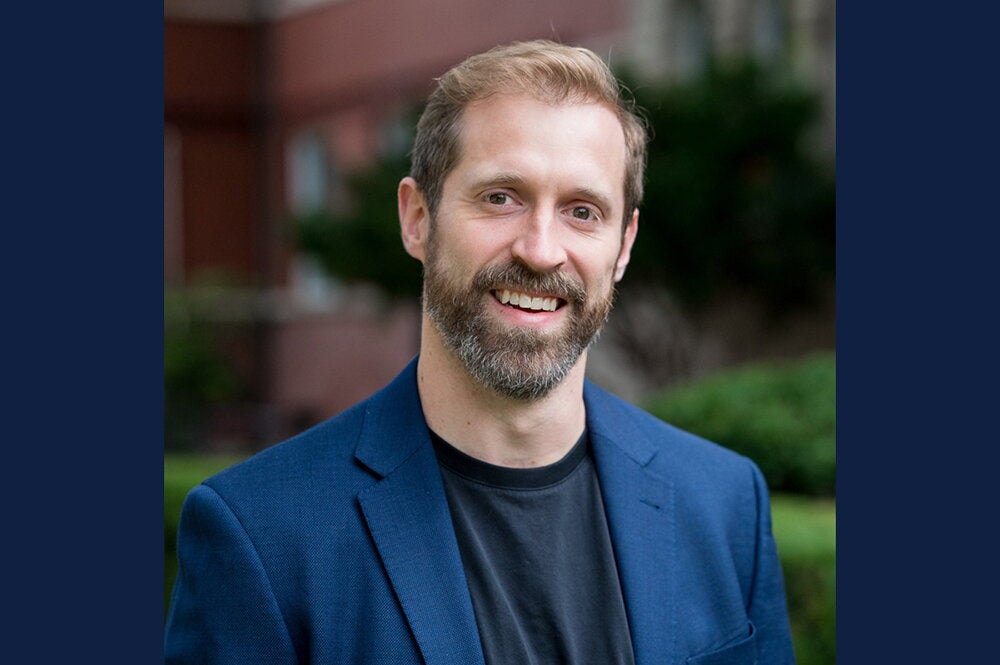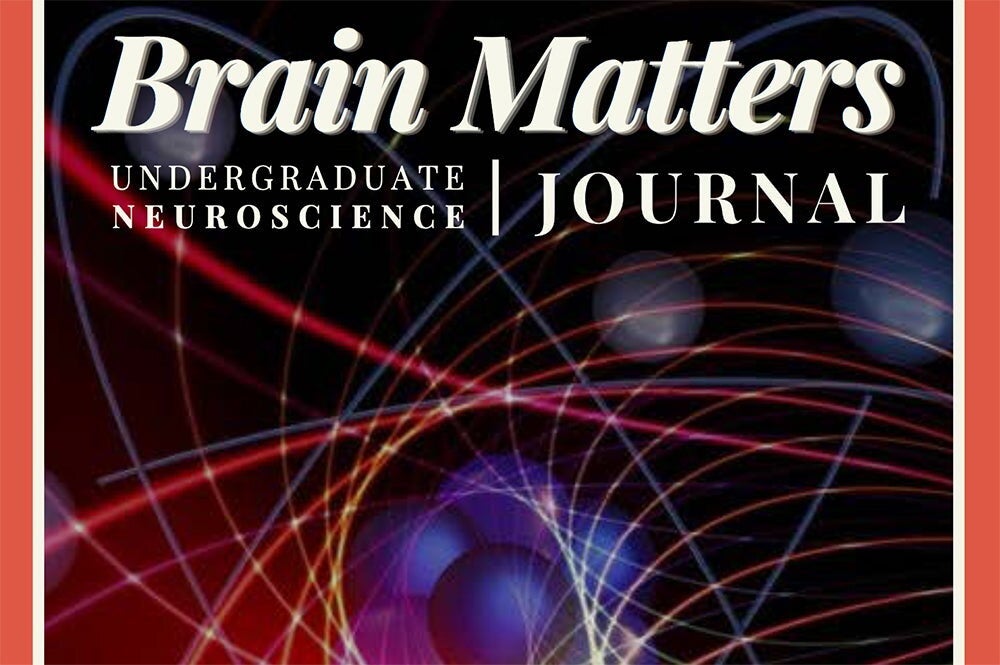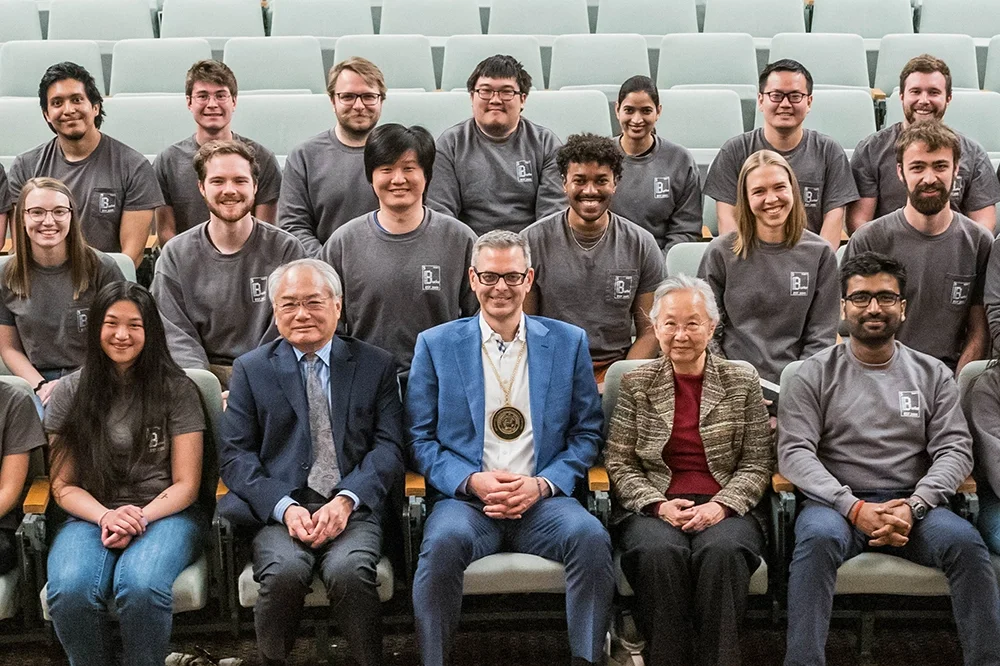
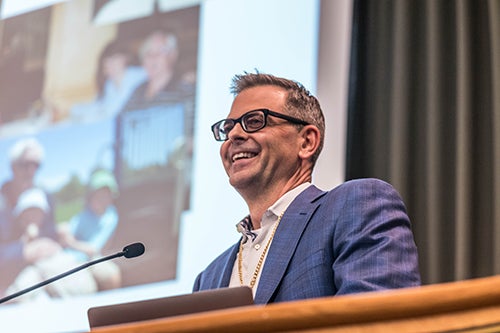
Martin D. Burke, a professor of chemistry and of the Carle Illinois College of Medicine, has been named the May and Ving Lee Professor for Chemical Innovation. Known for his contributions to pioneering lego-like automated small molecule synthesis, launching the field of molecular prosthetics, and developing and deploying rapid COVID-19 testing, Burke was honored recently in a ceremony at the Beckman Institute.
Seated throughout the auditorium were Burke’s family, friends, colleagues, and students, past and present. Burke thanked many in his speech, starting with his wife, M. Christina White, the William H. and Janet G. Lycan Professor of Chemistry at U of I, whom he met while they were studying at Johns Hopkins University in the late 1990s.
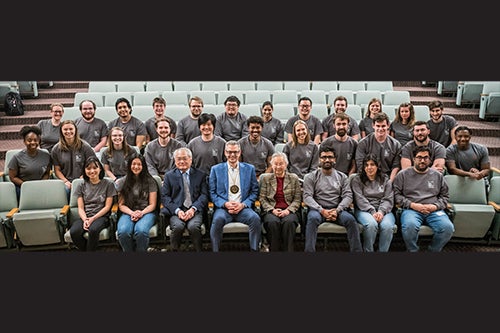
“It was the single most transformative moment of my life. I've learned more from Christina than anyone I've ever met,” Burke said. “I think the most important thing she taught me was how to dream audaciously at a scale that I never imagined. And then I watched her turn her own audacious dreams into reality, and I learned so much from her from that process. For this, I can never begin to express how eternally grateful I’m always going to be.”
Also in attendance were May (PhD, ’76, chemistry) and Ving (PhD, ’75, chemistry) Lee who received special recognition from Burke for their contributions to his research. May Lee went on to complete a postdoctoral fellowship at Harvard before joining the natural product discovery program at Lederle Laboratories, where she was awarded 14 U.S. patents. She is known for defining the enediyne structure of the calicheamicins, a class of antitumor antibiotics used to treat leukemia, through a combination of chemical and spectroscopic methods that reflected the best of her training at Illinois.
Ving Lee held postdoctoral fellowships at Harvard and the University of Illinois and went on to hold leaderships positions at Lederle, Microcide Pharmaceuticals, Iconix Biosciences, and Limerick Biopharma. He also served as chief executive officer and chief scientific officer (CSO) of Adesis Inc., where he continues as CSO to this day.
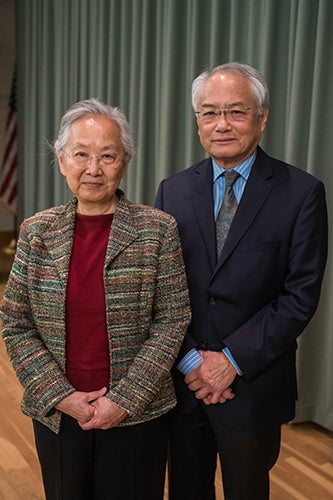
Burke made waves in 2016 when his team of researchers from Illinois, Harvard, and Northeastern University discovered that a small molecule called hinokitiol could be used to transport proteins in cells where protein transport is failing. This molecule was classified as a “molecular prosthetic” and used to treat protein deficiencies.
Since then his team has found another molecular prosthetic that is currently in clinical trials for the treatment of cystic fibrosis. These advances were driven by Burke’s “Lego-like way of building molecules”, which he is now working to further develop to allow more people to participate in the field of molecular synthesis.
“This could be a way to finally make it simple enough, compatible with automation and interfaced with artificial intelligence so that everybody could do it,” Burke said. “And do it in a meaningful way.”
Burke’s outlook played a critical role in his hiring at Illinois back in 2005, according to John Katzenellenbogen, professor of chemistry and Burke’s longtime colleague at Illinois. Katzenellenbogen said that a long-term goal is one of the first things they look for in professor candidates.
“We look for something that will really inspire us, and in Marty's case, it took us about 30 seconds to be convinced that this guy had a vision. It just blew us away,” Katzenellenbogen said.
Over the years Katzenellenbogen watched from across the hall as Burke’s molecular synthesis machines evolved. He also saw how Burke navigated the obstacles of someone trying to establish a new scientific industry.
“Marty had a lot of doubters as he was going into this,” Katzenellenbogen said. “They would say, ‘Well, you could do that. But what about this?’ (Then) Marty would always do something else and then they would say, ‘Oh, that works too.’”
In 2021, Burke was one of the key campus leaders who received the Presidential Medallion for their role in the development of the SHIELD test-and-trace system. The test provided a non-invasive, fast, and reliable saliva-based way to detect carriers of the COVID-19 virus. It was adopted across the state and other areas of the country.
"Their ingenuity and dedication and the hard work of thousands of their colleagues across the U of I System have saved lives on our campuses, in the surrounding communities, and well beyond,” said University of Illinois President Timothy Killeen, at the time. “Their efforts have demonstrated in real time what the U of I System means to the people of Illinois and ensured that our response to the pandemic has been unlike that of any university system in the world.”
Burke also thanked his undergraduate advisor, Henry Brem who is now the chief of Neurosurgery at Johns Hopkins. Brem allowed Burke into the operating room as an undergraduate to watch the surgeon remove a brain tumor and replace it with a wafer filled with chemotherapy that he’d invented. He also thanked his PhD advisor, professor Stuart Schreiber, who inspired him with the guidance, “if it doesn’t violate the laws of physics, it’s just a matter of time.”
Burke said that Brem suggested he thank him for the experience in his lab by passing on his knowledge to the next generation of scholars. Burke was heartened to see the crowd of former and current students who joined the ceremony at Beckman.
“I'm just tremendously grateful for this amazing team here, filling up the left side of the auditorium,” Burke said. “(These are) just brilliant, passionate, amazing young people who are in the process of launching their own rockets. It's just such a joy to be a part of that with you, both present and past students.”
